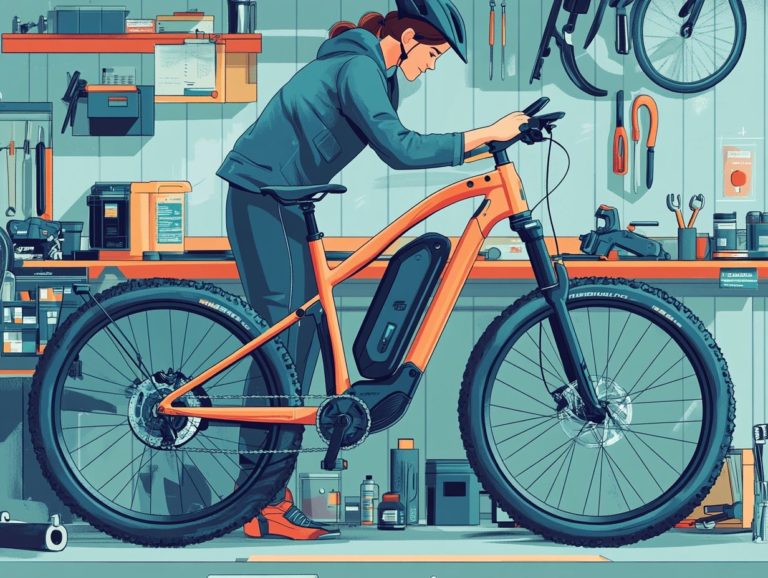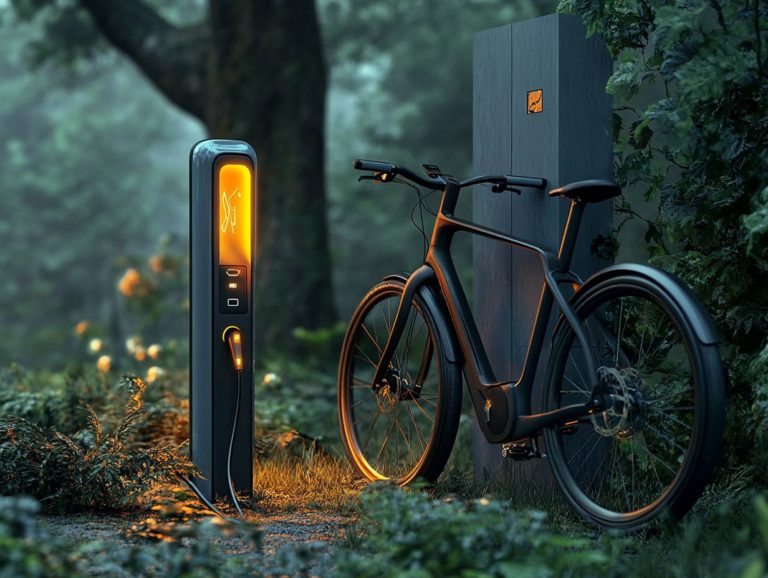What are the Different Motor Types in E-Bikes?
E-bikes have fundamentally transformed the way you perceive cycling, and at the heart of this evolution lies the motor.
Grasping the different types of motors hub, mid-drive, direct drive, and geared is crucial for anyone seeking to elevate their riding experience. Each motor type comes with its own set of advantages, performance characteristics, and considerations that deserve your attention.
Whether you re a leisurely rider or a dedicated cyclist, this guide will empower you to navigate the options and select the ideal motor for your e-bike journey.
Contents
Key Takeaways:
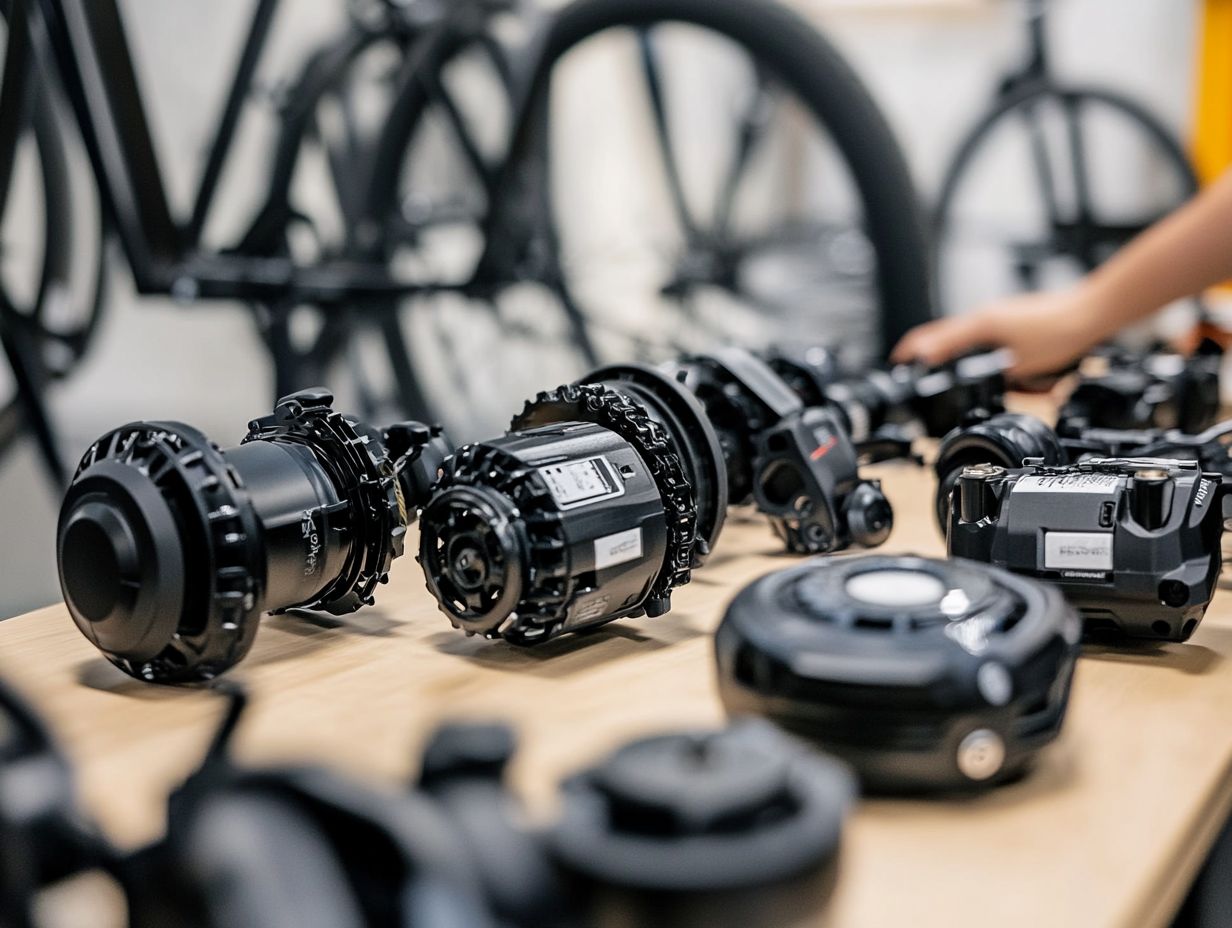
- Hub motors are the most common type of motor found in e-bikes, offering simplicity, reliability, and ease of maintenance.
- Mid-drive motors provide a more natural riding experience by using the bike’s gears, but can be more expensive and require more maintenance.
- Direct drive motors offer high torque and top speed but can be heavy and drain the battery more quickly.
Overview of Motor Types
In the realm of e-bikes, your choice of motor type plays a crucial role in determining performance, riding experience, and overall satisfaction. You’ll find various electric bike motors, such as hub motors, mid-drive motors, direct drive motors, and geared hub motors. Each of these is designed to cater to different riding styles and preferences. This diversity impacts essential factors like power output, torque, and efficiency.
Whether you’re a cycling enthusiast or a casual rider looking to enhance your commuting options or recreational rides, understanding different types of electric bicycles is vital. This overview highlights the characteristics and benefits of each motor type, guiding you toward making an informed decision that aligns with your specific needs.
Take hub motors, for example. Their simplicity and low maintenance make them an excellent choice for urban commuting. In contrast, mid-drive motors excel in providing better balance and increased torque, enabling you to conquer steep climbs with ease.
Each motor type also interacts uniquely with the bike’s battery technology, where aspects like battery capacity and how quickly the battery uses its power can significantly influence performance and efficiency. To explore more about electric bicycle types, check out the basics explained.
The motor you choose can also affect your riding comfort; some motors may produce more noise or vibrations than others, potentially detracting from your overall cycling experience. By understanding these nuances, you can align your preferences with the motor that best suits your lifestyle.
Hub Motors
Hub motors are a popular choice for many riders, delivering a smooth and efficient riding experience by embedding the motor directly into the wheel hub.
You can choose from rear hub motors, front hub motors, geared hub motors, and gearless hub motors, each tailored to different riding styles and preferences. To understand the 5 key differences between e-bike types, consider how these options offer distinct advantages, including straightforward installation and maintenance.
Understanding these differences now will help you get the best performance from your e-bike, especially in urban e-bikes and performance e-bikes, where efficiency and convenience take center stage.
How They Work and Their Benefits
Hub motors operate through electric assist technology, skillfully managed by a blend of sensors that measure how hard you’re pedaling. These sensors gauge your pedaling intensity and adjust the motor’s output to provide tailored assistance, enriching your riding experience whether you re a casual rider or a cycling aficionado.
By grasping the mechanics behind this technology, you can truly appreciate the efficiency and convenience that hub motors offer. They are especially effective when it comes to maintaining a smooth ride across diverse terrains.
This clever integration facilitates seamless transitions between manual and powered pedaling. It ensures that your efforts are met with just the right amount of assistance.
The advantages of hub motors go beyond mere user-friendliness; they also demand minimal maintenance compared to traditional gear systems. This makes them perfect for those who prefer a more straightforward upkeep routine.
These motors adapt easily to different riding styles whether you’re leisurely commuting or conquering steep hills, delivering consistent power that can significantly elevate your performance. To ensure your bike stays in top shape, check out this guide on how to maintain different electric bicycle types. As a result, you can revel in an effortless journey, seamlessly navigating through bustling city streets or meandering along picturesque trails.
Mid-Drive Motors
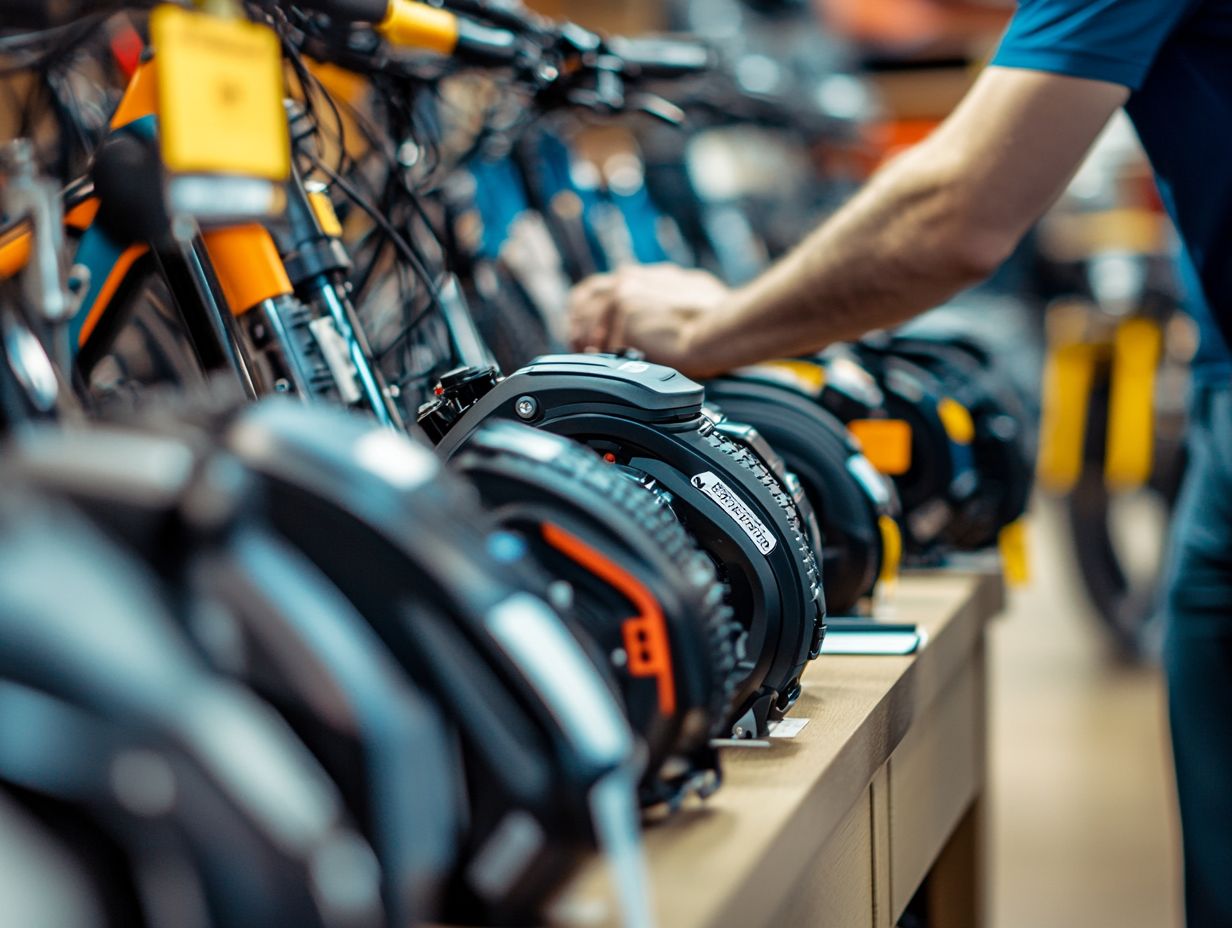
Love tackling tough terrains? Mid-drive motors are your best ally. They have gained considerable popularity among cycling enthusiasts, and for good reason.
By placing the motor at the bike’s center, mid-drive motors ensure better balance and efficient integration with the bike’s drivetrain components. This thoughtful design maximizes power output and delivers impressive torque, which is crucial for conquering steep inclines.
This ultimately elevates the entire riding experience and enhances your ability to navigate rugged trails.
Advantages and Disadvantages
Mid-drive motors come with a unique mix of advantages and disadvantages that can significantly influence your riding experience and maintenance routine. They deliver impressive torque output for tackling steep terrains and provide a more natural ride feel by leveraging your bike’s gears.
The design can be complex, leading to more maintenance needs compared to hub motors. This consideration is particularly important for enthusiasts like you, who often seek out challenging routes.
With a mid-drive system engaging your bike s transmission, you enjoy improved efficiency on varied inclines. This allows you to tackle long distances without succumbing to fatigue.
That said, the intricate mechanics do require consistent upkeep and repair. This may deter those who prefer the simplicity of a low-maintenance hub motor system.
When comparing mid-drives to hub motors, which generally require less servicing and offer straightforward installation, you may find yourself weighing the trade-off between performance and convenience. Ultimately, your choice will depend on your personal riding preferences and priorities.
Direct Drive Motors
Direct drive motors are celebrated for their exceptional performance and reliability, positioning them as an ideal choice for high-performance electric bicycles.
Unlike geared systems, direct drive motors operate without intermediary gears, resulting in a smoother ride while significantly reducing maintenance requirements.
These motors shine in power output and energy management. They are particularly appealing to cycling enthusiasts who seek a seamless riding experience across diverse terrains.
Upgrade to a direct drive motor today and enjoy a smoother ride tomorrow!
Features and Performance
In terms of features, direct drive motors shine with their impressive efficiency and torque output. They deliver a powerful riding experience due to the direct connection between the motor and the wheel, ensuring best use of energy for peak performance, especially in challenging conditions.
This design provides significantly higher torque, enabling rapid acceleration and exceptional handling across various riding styles. In contrast to brushed or brushless geared motors, direct drive systems typically showcase improved efficiency, minimizing energy loss and extending battery life. This efficiency is especially advantageous for electric bikes and performance scooters, where responsive power delivery and reliability are paramount. To explore more about different options, check out electric bicycle types.
As you navigate diverse terrains, the advantages of direct drive motors become evident, allowing for smoother transitions and a more connected riding experience whether you’re cruising through bustling city streets or tackling rugged off-road trails.
Geared Motors
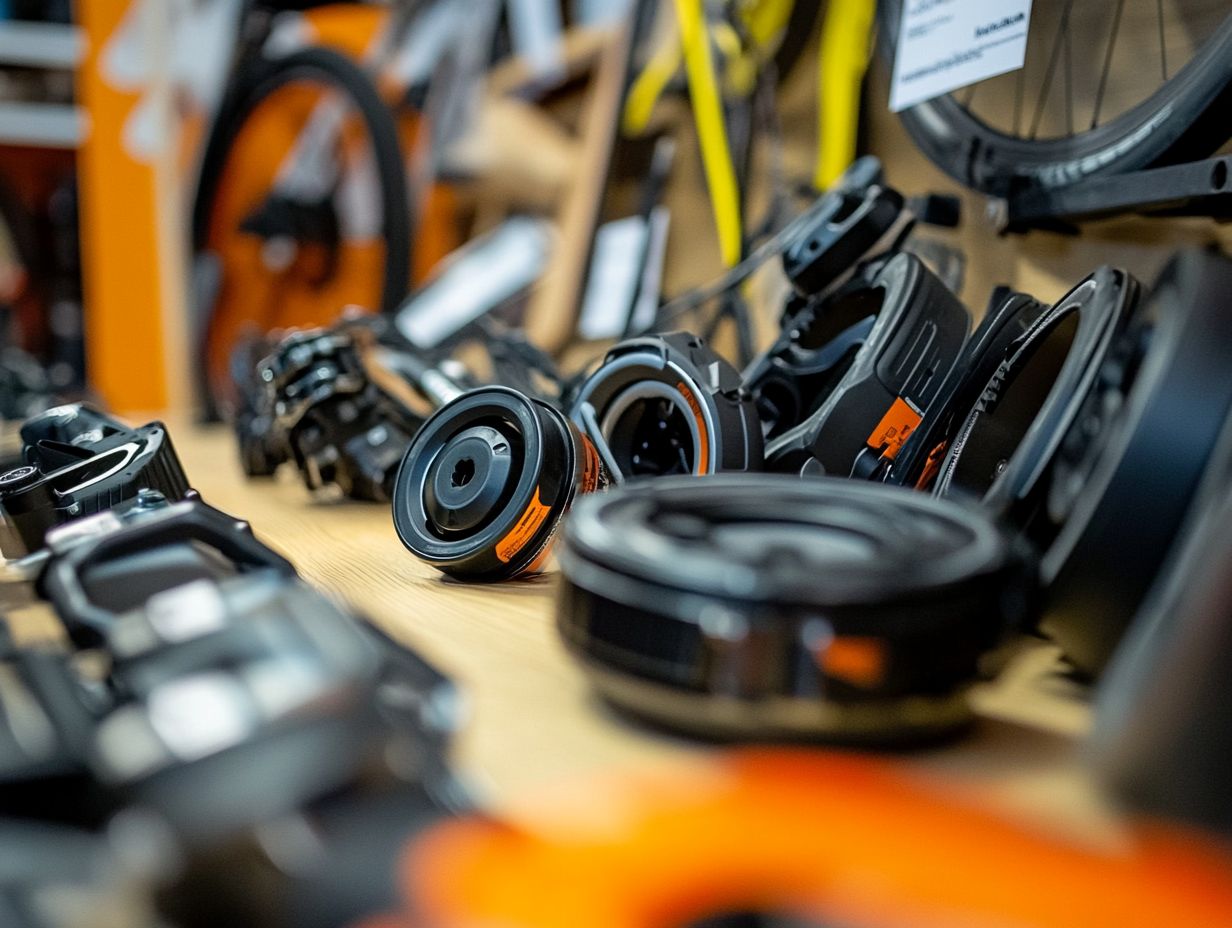
Geared motors provide a distinctive method for propelling electric bikes, leveraging gears to enhance torque output and optimize performance, especially in demanding riding conditions. This technology proves especially advantageous for performance eBikes, where pedal assist which means the motor helps you pedal, making riding easier can substantially amplify your input.
As a result, you ll find it much easier to conquer steep hills or navigate the complexities of urban landscapes.
Pros and Cons of Geared Systems
Geared systems come with a variety of pros and cons that could significantly influence their suitability for you as a rider. On the upside, geared hub motors typically provide higher torque output and efficiency, making them particularly advantageous when navigating steep terrains.
However, this complexity also means they may require more maintenance, a crucial factor to consider if you’re in the market.
If you’re a mountain biker facing challenging hills, you might find yourself reaping the benefits of a geared motor’s torque advantages. This allows you to ascend with remarkable ease and truly enhances your riding experience, especially on rugged trails.
If you re more of a casual rider, the upkeep of these systems such as regular inspections and potential gear replacements might feel like an inconvenient chore, both time-consuming and costly. While geared motors excel in performance, their added weight could deter you if you’re looking for a lightweight option for city commuting.
Understanding these factors is essential for making an informed choice that best suits your riding style and needs.
Choosing the Right Motor for Your E-Bike
Choosing the right motor for your e-bike is a vital decision that can significantly influence your riding experience, efficiency, and overall satisfaction. You’ll want to consider several factors, including battery size, your riding style, and budget constraints.
Familiarizing yourself with the different types of motors available hub motors, mid-drive motors, and geared systems is also essential. By conducting a comprehensive eBike motor comparison, you can ensure you find the perfect match tailored to your unique needs and preferences.
Don’t miss out on the benefits of direct drive motors! Explore our range of e-bike motors today to find your perfect match!
Factors to Consider and Personal Preferences
When you re selecting a motor for your electric bike, it s vital to understand factors like how efficient the motor is, your riding style, and how much power it uses. Understanding these factors will help you enjoy every thrilling moment on your ride!
Your personal preferences matter greatly.
Different riders often prioritize elements like torque output, which is the force that helps you start moving or climb hills, or energy management based on their unique needs. For a deeper insight into various options, check out electric bike types.
For example, if you’re a commuter navigating city traffic, you might gravitate towards a motor that boasts high efficiency and quick acceleration, allowing you to zip through intersections with ease. If you’re an adventure seeker, you’ll want a motor that offers superior torque, enabling you to conquer steep hills without losing speed. To explore more about the different options available, check out electric bicycle types and what you need to know.
Battery management is also crucial. If you enjoy long rides, choose a motor that uses power efficiently. This way, you can ride farther without needing to recharge often.
Frequently Asked Questions
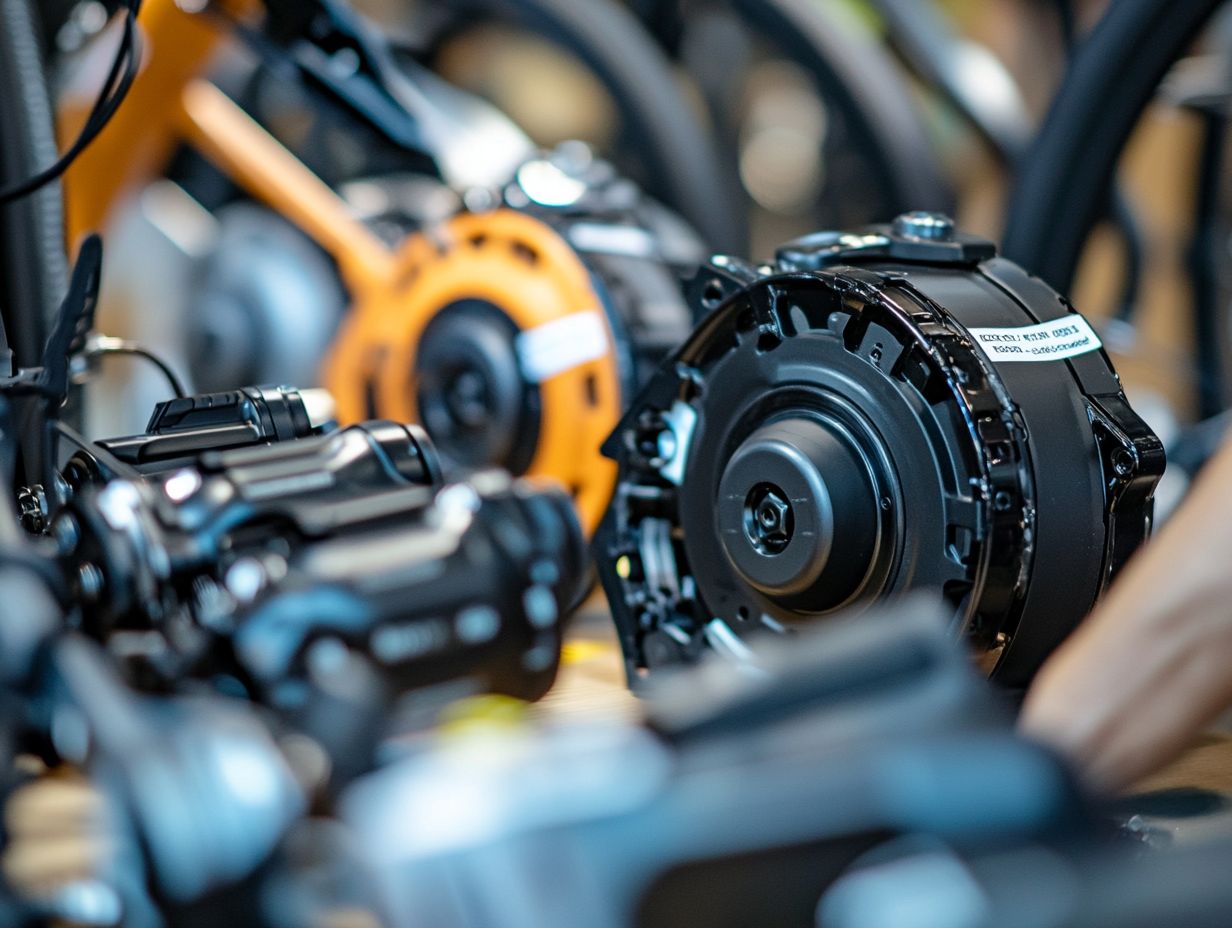
What are the Different Motor Types in E-Bikes?
There are three main types of motors used in E-Bikes: hub motors, mid-drive motors, and friction drive motors. Each has its own unique characteristics and benefits.
What is a Hub Motor in an E-Bike?
A hub motor is a type of motor built into the hub of one of the wheels of an E-Bike. This motor is often seen in budget-friendly e-bikes and provides a simple and straightforward power source.
What is a Mid-Drive Motor in an E-Bike?
A mid-drive motor is integrated into the bike’s drivetrain, usually between the pedals. This motor provides a more natural riding experience as the power is distributed through the gears of the bike.
What is a Friction Drive Motor in an E-Bike?
A friction drive motor is attached to the side of the rear wheel and uses friction to propel the bike forward. This type of motor is less common and is usually found in DIY or custom E-Bikes.
Which Motor Type is Best for Hilly Terrain?
A mid-drive motor is generally considered the best type of motor for hilly terrain. It provides more torque and utilizes the bike’s gears to effectively climb steep hills.
Which Motor Type is Best for Long Distance Riding?
A hub motor is often regarded as the best type of motor for long-distance riding. It provides a smooth and steady power source, making it ideal for longer rides.
Ready to choose your ideal e-bike motor? Dive into your options today!

